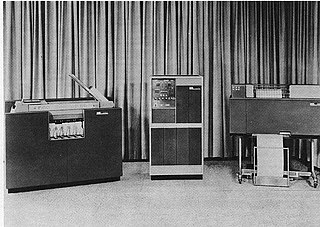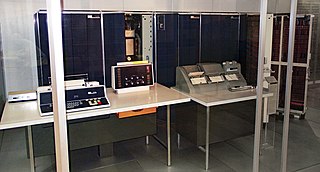
The IBM System/360 (S/360) is a family of mainframe computer systems announced by IBM on April 7, 1964, and delivered between 1965 and 1978. System/360 was the first family of computers designed to cover both commercial and scientific applications and a complete range of applications from small to large. The design distinguished between architecture and implementation, allowing IBM to release a suite of compatible designs at different prices. All but the only partially compatible Model 44 and the most expensive systems use microcode to implement the instruction set, featuring 8-bit byte addressing and fixed-point binary, fixed-point decimal and hexadecimal floating-point calculations.

CP-67 is a hypervisor, or Virtual Machine Monitor, from IBM for its System/360 Model 67 computer.

IBM 1442 is a combination IBM card reader and card punch. It reads and punches 80-column IBM-format punched cards and is used on the IBM 1440, the IBM 1130, the IBM 1800 and System/360 and is an option on the IBM System/3.
Disk Operating System/360, also DOS/360, or simply DOS, is the discontinued first member of a sequence of operating systems for IBM System/360, System/370 and later mainframes. It was announced by IBM on the last day of 1964, and it was first delivered in June 1966. In its time, DOS/360 was the most widely used operating system in the world.

The IBM 1403 line printer was introduced as part of the IBM 1401 computer in 1959 and had an especially long life in the IBM product line.

The IBM 1400 series are second-generation (transistor) mid-range business decimal computers that IBM marketed in the early 1960s. The computers were offered to replace tabulating machines like the IBM 407. The 1400-series machines stored information in magnetic cores as variable-length character strings separated on the left by a special bit, called a "wordmark," and on the right by a "record mark." Arithmetic was performed digit-by-digit. Input and output support included punched card, magnetic tape, and high-speed line printers. Disk storage was also available.

The text-only monochrome IBM 2260 cathode-ray tube (CRT) video display terminal plus keyboard was a 1964 predecessor to the more-powerful IBM 3270 terminal line which eventually was extended to support color text and graphics.

The Standard Modular System (SMS) is a system of standard transistorized circuit boards and mounting racks developed by IBM in the late 1950s, originally for the IBM 7030 Stretch. They were used throughout IBM's second-generation computers, peripherals, the 7000 series, the 1400 series, and the 1620. SMS was superseded by Solid Logic Technology (SLT) introduced with System/360 in 1964, however they remained in use with legacy systems through the 1970s.

IBM 7070 is a decimal-architecture intermediate data-processing system that was introduced by IBM in 1958. It was part of the IBM 700/7000 series, and was based on discrete transistors rather than the vacuum tubes of the 1950s. It was the company's first transistorized stored-program computer.

The IBM 2540 is a punched-card computer peripheral manufactured by IBM Corporation for use of System/360 and later computer systems. The 2540 was designed by IBM's Data Processing Division in Rochester, Minnesota, and was introduced in 1965. The 2540 can read punched-cards at 1000 cards per minute (CPM) and punch at 300 CPM. The 2540 is based on the design of the older, slightly slower, 1402.
The IBM 2780 and the IBM 3780 are devices developed by IBM for performing remote job entry (RJE) and other batch functions over telephone lines; they communicate with the mainframe via Binary Synchronous Communications and replaced older terminals using synchronous transmit-receive (STR). In addition, IBM has developed workstation programs for the 1130, 360/20, 2922, System/360 other than 360/20, System/370 and System/3.
POWER was an IBM operating system enhancement package that provided spooling facilities for the IBM System/360 running DOS/360 or retrofitted with modified DOS/360. Upgrades, POWER/VS and POWER/VSE were available for and the IBM System/370 running DOS/VS and DOS/VSE respectively. POWER is an acronym for Priority Output Writers, Execution processors and input Readers.

The IBM System/360 Model 20 is the smallest member of the IBM System/360 family announced in November 1964. The Model 20 supports only a subset of the System/360 instruction set, with binary numbers limited to 16 bits and no floating point arithmetic. In later years it would have been classified as a 16-bit minicomputer rather than a mainframe, but the term "minicomputer" was not current, and in any case IBM wanted to emphasize the compatibility of the Model 20 rather than its differences from the rest of the System/360 line. It does, however, have the full System/360 decimal instruction set, that allows for addition, subtraction, product, and dividend of up to 31 decimal digits.
The IBM 2922 Programmable Terminal is a Remote Job Entry (RJE) terminal introduced by IBM in 1972. The 2922 communicates using Binary Synchronous Communications (Bisync).
Attached Support Processor (ASP) was an implementation of loosely coupled multiprocessing for IBM's OS/360 operating system. IBM later changed the name to Asymmetrical multiProcessor but retained the acronym ASP.
Beginning with its 1964 System/360 announcement, IBM's mainframes initially accessed count key data (CKD) subsystems via a channel connected to separate Storage Control Units (SCUs) with attached Direct Access Storage Devices (DASD), typically a hard disk drive. This practice continued in IBM's larger mainframes thru IBM Z; however low end systems generally used lower cost integrated attachments where the function of the SCU was combined with that of the channel, typically called an Integrated File Adapter.

The IBM System/360 Model 25 is a low-end member of the IBM System/360 family. It was announced on January 3, 1968, 3 years before the IBM System/360 Model 22, as a "bridge between its old and new computing systems".
In addition to the drums used as main memory by IBM, e.g., IBM 305, IBM 650, IBM offered drum devices as secondary storage for the 700/7000 series and System/360 series of computers.

IBM developed, manufactured and sold hammer-based impact printers that used either type bars, a chain, a train, or a band to create printed output from 1959 till 1999, replacing the older print drum technology,. Over the course of this time they produced a wide variety of these line printers. This article will detail the most significant ones. Note that while IBM initially described band printers as belt printers, they are effectively the same thing.











